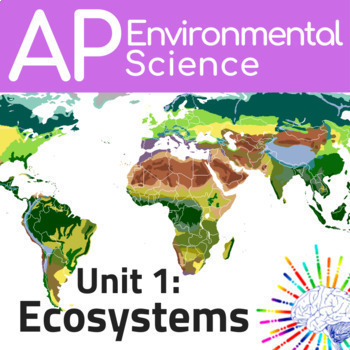AP Environmental Science (APES) Complete Review Unit 1: Ecosystems
- Google Docs™

What educators are saying
Also included in
- Review and Learning Guides for full year - all Nine AP Environmental Science Units, aligned to the AP Environmental Science Course and Exam Description! Students will know exactly what College Board expects them to learn. Each Essential Standard is written out on the left side of the paper, with focPrice $73.00Original Price $82.00Save $9.00
Description
Review and study resources for APES Unit 1: Ecosystems. Aligned to the AP Environmental Science Course and Exam Description! Works great as an AP Environmental Science Test Review or learning guide for your Ecosystems Unit!
Students will know exactly what College Board expects them to learn. Each Essential Standard is written out on the left side of the paper, with focused, aligned, open ended questions on the right side for students to work through.
Most of the questions are open ended, asking students to think critically and put concepts together in meaningful ways. Students are also asked to draw, label, and annotate diagrams, create graphs, explain data sets, and justify reasoning.
Review and Study Questions for all eleven Topics in Unit 1: Ecosystems
- 1.1 Introduction to Ecosystems
- 1.2 Terrestrial Biomes
- 1.3 Aquatic Biomes
- 1.4 The Carbon Cycle
- 1.5 The Nitrogen Cycle
- 1.6 The Phosphorous Cycle
- 1.7 The Hydrologic (Water) Cycle
- 1.8 Primary Productivity
- 1.9 Trophic Levels
- 1.10 Energy Flow and the 10% Rule
- 1.11 Food Chains and Food Webs
Product includes a link to a digital copy of the document. Open it in Google Docs and then make a copy for your own Google Drive to edit as needed!
Includes a full answer key!
**BONUS** Save hours of time searching for resources to teach with! Purchase includes a list of links to 55 extra resources - arranged and organized for each unit topic. The list includes online interactive activities, video clips, and Lab ideas and classroom activities for your students.
Your AP Environmental Science students benefit tremendously from having quick access to the Essential Knowledge standards and these guiding questions. After going through each set, they will feel confident they are ready for the Exam!
This resource can be used several ways:
- While going through a Unit as a working document, a learning guide, students can add to it as they read though the text book or listen to lecture
- To complete just before a Unit test as a study guide
- At the end of the semester to prepare for the AP Environmental Science Exam
When used as a learning guide: It is helpful to have students begin the Unit by going through the Essential Knowledge itself, highlighting key vocabulary. This gives them a good foundation to grow from, they know what to look for and what is important as they learn about, or review for the Unit.
When my students use these as review, I put them into small groups of three or four. They work together to complete the questions. Then students get into new groups and review their answers. I help guide them and help with questions that they can not come to an agreement on.
More for AP Environmental Science!
- APES Unit 1: Ecosystems
- APES Unit 2: Biodiversity
- APES Unit 3: Populations
- APES Unit 4: Earth Systems and Resources
- APES Unit 5: Land and Water Use
- APES Unit 6: Energy Resources and Conservation
- APES Unit 7: Atmospheric Pollution
- APES Unit 8: Land and Water Pollution
- APES Unit 9: Global Change
Get all Nine Units in one BUNDLE and SAVE!
Looking for more Science resources?
- Biomolecules Review Dot Game! A different, no-tech way to review
- Biomolecules Review - Up and Moving speed date activity!
- Ecosystem Project - differentiated project based learning
- Hidden Life of the Cell video guide - an excellent 60 minute video putting you inside a living cell!
- Photosynthesis Online Activity Guided Notes - Gamify Photosynthesis!
- Evolution and Natural Selection Review activity
- FREE Instinctive Animal Behavior Speed Dating Review Activity
- Bacteria Dichotomous Key Activity - use QR codes to ‘infect’ students with an unknown species of bacteria. They use the Key to figure it out what they have!
- NO PREP Cladogram Activity: What Does T-Rex Taste Like? Student Guide to an Online Interactive
- Fifty Biology Writing Prompts! Increase Literacy in your science classroom. Great for Bell Ringers, class discussion, and assessments
**Stay Curious! **





